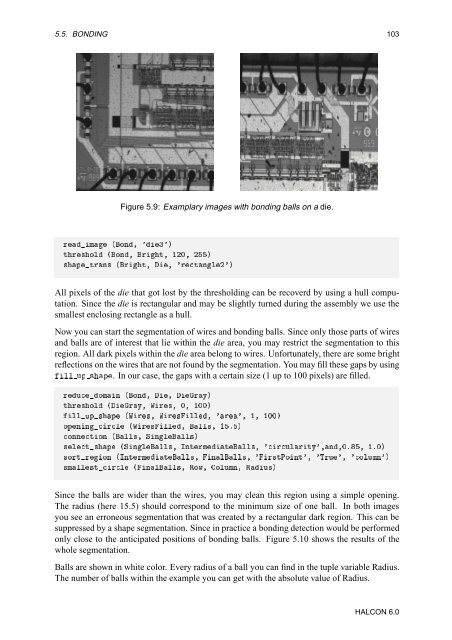You also want an ePaper? Increase the reach of your titles
YUMPU automatically turns print PDFs into web optimized ePapers that Google loves.
5.5. BONDING 103<br />
Figure 5.9: Examplary images with bonding balls on a die.<br />
ÖÑ ´ÓÒ¸ ³¿³µ<br />
ØÖ×ÓÐ ´ÓÒ¸ Öظ ½¾¼¸ ¾µ<br />
×ÔØÖÒ× ´Öظ ¸ ³ÖØÒо³µ<br />
All pixels of the die that got lost by the thresholding can be recoverd by using a hull computation.<br />
Since the die is rectangular and may be slightly turned during the assembly we use the<br />
smallest enclosing rectangle as a hull.<br />
Now you can start the segmentation of wires and bonding balls. Since only those parts of wires<br />
and balls are of interest that lie within the die area, you may restrict the segmentation to this<br />
region. All dark pixels within the die area belong to wires. Unfortunately, there are some bright<br />
reflections on the wires that are not found by the segmentation. You may fill these gaps by using<br />
ÐÐ ÙÔ ×Ô. In our case, the gaps with a certain size (1 up to 100 pixels) are filled.<br />
ÖÙÓÑÒ ´ÓÒ¸ ¸ Öݵ<br />
ØÖ×ÓÐ ´Öݸ ÏÖ׸ ¼¸ ½¼¼µ<br />
ÐÐÙÔ×Ô ´ÏÖ׸ ÏÖ×Ðи ³Ö³¸ ½¸ ½¼¼µ<br />
ÓÔÒÒÖÐ ´ÏÖ×Ðи ÐÐ׸ ½ºµ<br />
ÓÒÒØÓÒ ´ÐÐ׸ ËÒÐÐÐ×µ<br />
×ÐØ×Ô ´ËÒÐÐÐ׸ ÁÒØÖÑØÐÐ׸ ³ÖÙÐÖØݳ¸Ò¸¼º¸ ½º¼µ<br />
×ÓÖØÖÓÒ ´ÁÒØÖÑØÐÐ׸ ÒÐÐÐ׸ ³Ö×ØÈÓÒس¸ ³ÌÖÙ³¸ ³ÓÐÙÑÒ³µ<br />
×ÑÐÐ×ØÖÐ ´ÒÐÐÐ׸ ÊÓÛ¸ ÓÐÙÑÒ¸ ÊÙ×µ<br />
Since the balls are wider than the wires, you may clean this region using a simple opening.<br />
The radius (here 15.5) should correspond to the minimum size of one ball. In both images<br />
you see an erroneous segmentation that was created by a rectangular dark region. This can be<br />
suppressed by a shape segmentation. Since in practice a bonding detection would be performed<br />
only close to the anticipated positions of bonding balls. Figure 5.10 shows the results of the<br />
whole segmentation.<br />
Balls are shown in white color. Every radius of a ball you can find in the tuple variable Radius.<br />
The number of balls within the example you can get with the absolute value of Radius.<br />
HALCON 6.0
















